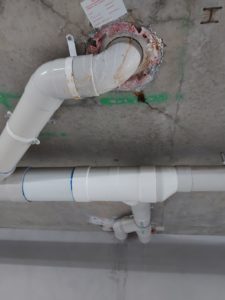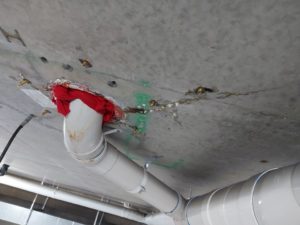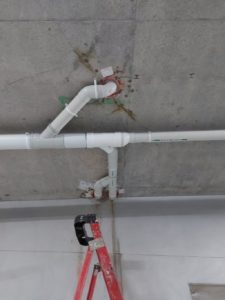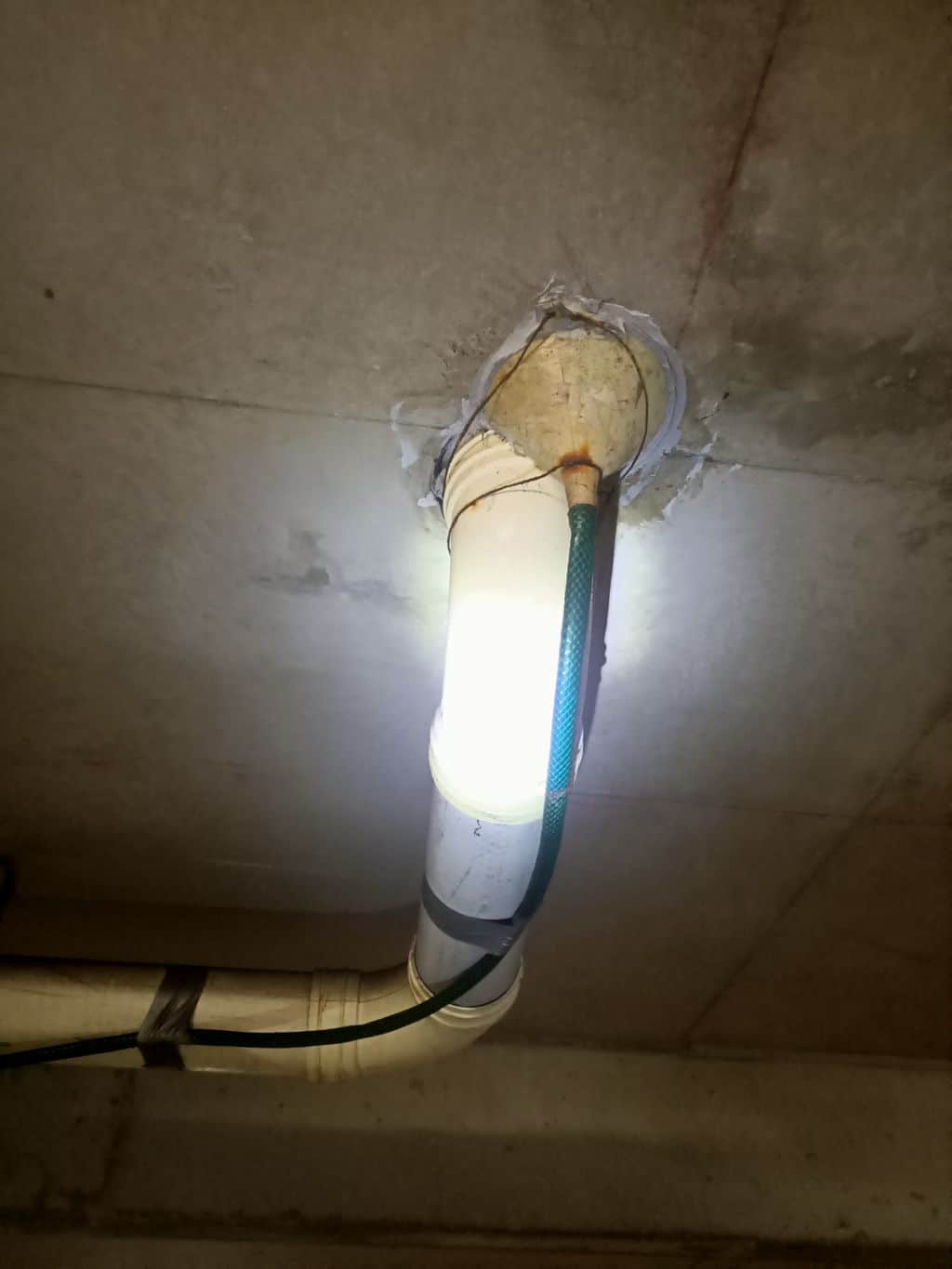
10 Feb Why are drip trays not a long term solution to water ingress?
“… 𝗙𝗼𝗹𝗹𝗼𝘄 𝘁𝗵𝗲 𝗴𝗮𝗿𝗱𝗲𝗻 𝗵𝗼𝘀𝗲 …” 𝗪𝗵𝗮𝘁 𝗶𝘀 𝘁𝗵𝗲 𝗺𝗼𝘀𝘁 𝗶𝗻𝘃𝗲𝗻𝘁𝗶𝘃𝗲 “𝗱𝗿𝗶𝗽 𝘁𝗿𝗮𝘆” 𝘆𝗼𝘂 𝗵𝗮𝘃𝗲 𝘀𝗲𝗲𝗻?
– “Band-aid” fixes like drip trays/drip pans can accelerate and hide symptoms of rusting reinforcing steel embedded in the concrete slab.
The inventive solution to a leaking pipe penetration in the video above shows that while the water is re-directed, the issue has not been rectified. Moisture is still allowed to travel through the pathway of the pipe penetration. Drip trays can hide visual signs of concrete cancer, like delamination, spalling, calcium deposits (e.g. calthemite stalactites), efflorescence (salt deposits), rust stains from embedded reinforcing steel, exposed rebar. Corrosion of reinforcing steel and other embedded metals is the leading cause of deterioration in concrete.
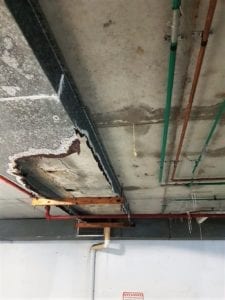
Rusted drip tray and spalling concrete in a car park.
This is why installing drip trays/drip pans are a short-term solution. They re-direct water leaks in concrete slab ceilings, but they do not fix the root cause. To protect against asset deterioration, to ensure a longer asset lifetime and avoid an increased long-term capital cost, we recommend leak sealing injections that will stop water from entering and travelling through the pathway of the core hole in the concert slab. Concrete repairs are also advised as part of the solution if required.
Why is leaking pipe penetrations a common problem?
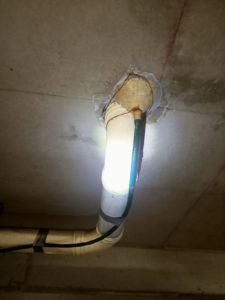
Garden hose and funnel to redirect water in a garage. (Installed by others.)
Water leaks around pipe penetrations/core holes for gas, water, sewer and electrical lines, is a prevalent problem. A common reason is that they are sealed with a cement-based water plug or a patch from the interior side of the building during original construction. The bond to the concrete fails over time, allowing a pathway for water to leak around the pipe penetration. The plug does not seal the gaps throughout the whole wall or slab and eventually, water finds its way into the gaps and leaks through the wall or slab around the pipe. Another common reason is that when a hole for the pipe is drilled through the concrete, the coring process through the concrete wall or slab can cause damage to the concrete structure by creating cracks or breaking chips out of concrete. This can provide a direct path for water to pass through the concrete.
Any water that finds a seepage path through cracks and air voids present in concrete will readily carry minerals such as calcium hydroxide and calcium ion to the underside of the structure. When the leachate solution makes contact with the carbon dioxide in the air, it causes a chemical reaction, which deposits calcium carbonate on the outside of the concrete structure.
Other trace elements such as iron from rusting reinforcing steel may be transported and deposited by the leachate at the same time as the calcium carbonate. This may give the calthemites an orange or red tint. The sight of calthemite is a visual sign that calcium is being leached from the concrete structure and may indicate that the concrete is gradually degrading. In steel-reinforced concrete, the presence of water, oxygen and chlorides breaks down the alkaline protection provided by the concrete to the steel, and this can lead to the development of concrete cancer if left untreated.
A correct and cost-effective solution
Waterstop Solutions leak sealing injection and remedial waterproofing specialists frequently carry out leak sealing injections that will stop water from entering and travelling through the pathway of the core hole in the concrete slab.
- Before leak sealing injections
- During leak sealing injections
- Pipe penetration leak sealed. Injection ports pulled and holes plugged with a rapid setting repair mortar.
𝗕𝗼𝗼𝗸 𝗮𝗻 𝗶𝗻𝘀𝗽𝗲𝗰𝘁𝗶𝗼𝗻 𝘄𝗶𝘁𝗵 𝗼𝗻𝗲 𝗼𝗳 𝗼𝘂𝗿 𝗲𝘅𝗽𝗲𝗿𝗶𝗲𝗻𝗰𝗲𝗱 𝗶𝗻𝘀𝗽𝗲𝗰𝘁𝗼𝗿𝘀 𝘁𝗼𝗱𝗮𝘆!
Contact our friendly team today
Waterstop Solutions inspectors are equipped with extensive industry knowledge and the latest in non-invasive inspection technologies. Our thorough site assessment and diagnosis process provides our clients with industry-leading, expert advice.
𝗜𝗻 𝗮𝗱𝗱𝗶𝘁𝗶𝗼𝗻 𝘁𝗼 𝗼𝘂𝗿 𝗿𝗲𝗴𝘂𝗹𝗮𝗿 𝗶𝗻𝘀𝗽𝗲𝗰𝘁𝗶𝗼𝗻 𝘀𝗲𝗿𝘃𝗶𝗰𝗲, 𝘄𝗲 𝗰𝗮𝗻 𝗽𝗿𝗼𝘃𝗶𝗱𝗲 𝗮𝘂𝗱𝗶𝘁𝘀 𝗼𝗳 𝗺𝘂𝗹𝘁𝗶-𝘀𝘁𝗼𝗿𝘆 𝗰𝗼𝗻𝗰𝗿𝗲𝘁𝗲 𝗯𝘂𝗶𝗹𝗱𝗶𝗻𝗴𝘀. The audit consists of a defect information list of items classed in priorities from P1 to P4, and their repair types. Ask us about how to secure a booking for this additional service.
Brisbane office: (07) 3205 1899
Email: [email protected]
Sydney office: (02) 9346 8308
Email: [email protected]
Good maintenance begins with a proactive approach to maintain, keep, preserve and protect a building.
Remember that seepage/water ingress into areas such as basements, concrete roofs, car parks and retaining walls, should not be ignored – call a remedial waterproofing professional today for an assessment to provide you with the best solution for your situation.
At Waterstop Solutions, we carry out a wide range of remedial works to concrete structures post construction stage.
Equipped with major civil works experience, we can quickly determine the best approach to rectify all seepage and concrete deterioration issues.


